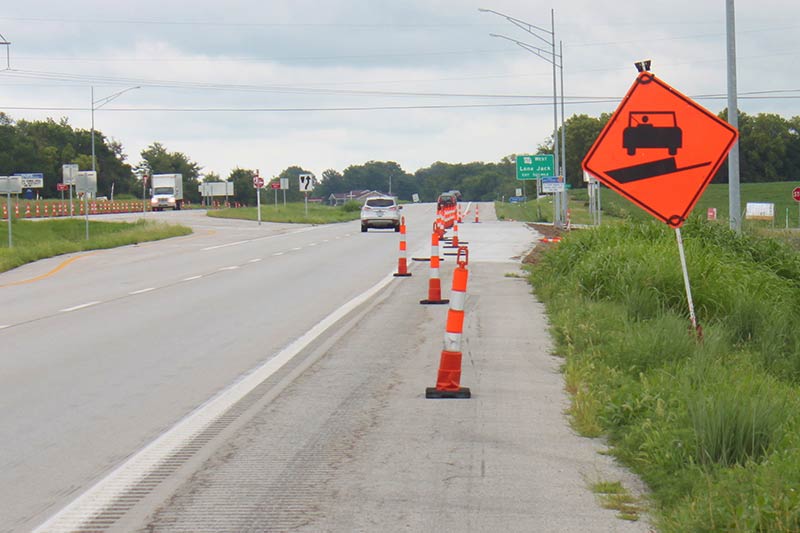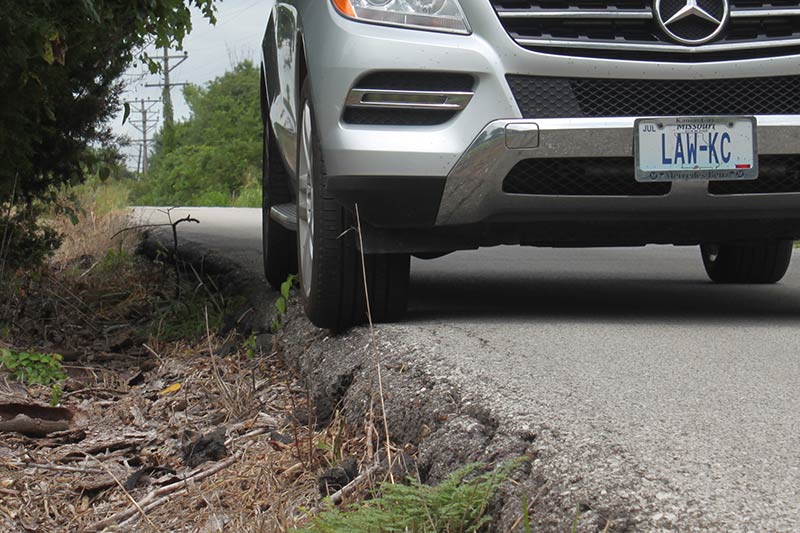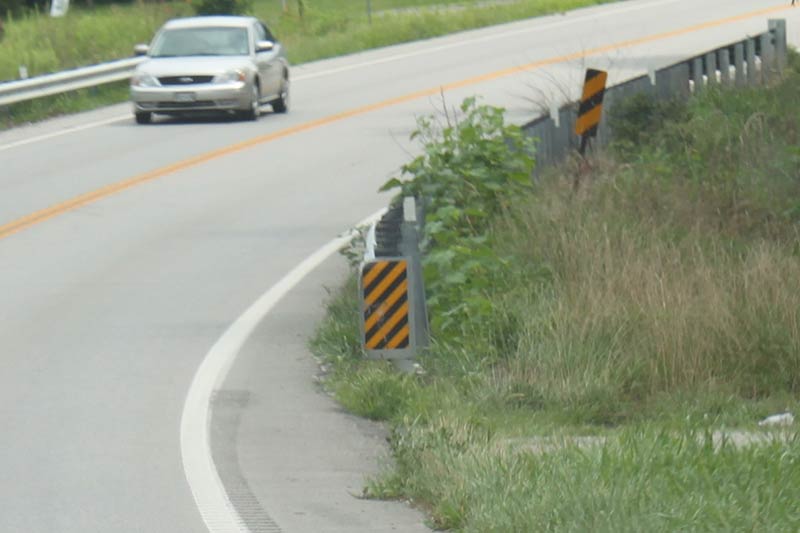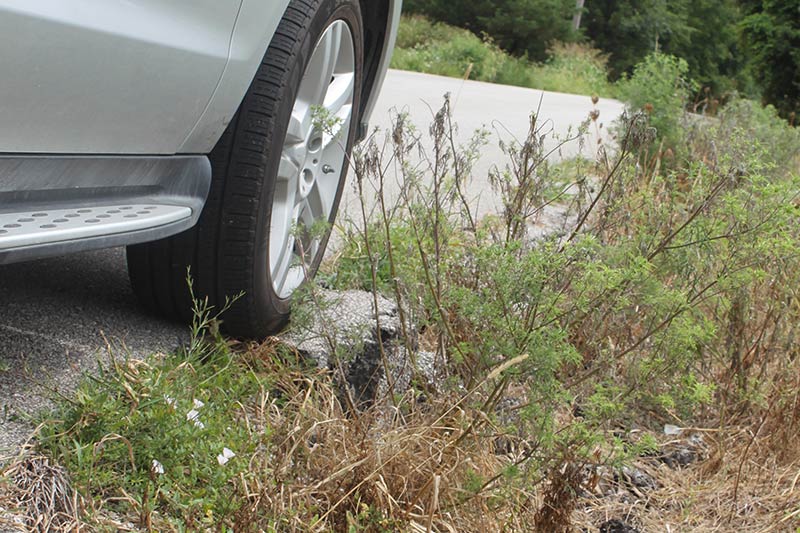Auto accidents don’t always have a clear cause or “person” to make a claim agains. Many Missouri car accidents are not the result of the negligence of a particular driver but rather the condition of the roadway itself.
The defective roadway condition lawyers at Hamilton & Associates have more than forty years’ experience bringing cases where a person has been killed or injured as a result of a roadway defect.
Roadway design, manufacturer, maintenance, and construction defect cases are an unusual area of the law and, as a result best handled by attorneys with skill and experience in the area. Call us if you believe you have had a car accident caused by a defective roadway condition.
The History of Roadway Defects
The Campaign Era: Before 1966, in what has been called “Campaign Era,” there were public service announcements with titles such as “The Life You Save may be Your Own” and “Speed Kills.” Such slogan films had temporary effects on improvements in the skill and safety of drivers.
The long term effects of the Campaign Era appear to have been negligible. This was the post-World War II road building era, most noted by President Eisenhower’s interstate system. While United States troops occupied Germany, they saw the Autobahn and its wonders, spurring them to create highway clear zones, effective intersection control, and other road safety features. The United States improved upon these innovations with the advent of the Campaign Era of road building.
The freewheeling 1966 Campaign Era also marked a large increase in law enforcement to uphold roadway laws. The money available to the United States citizens increased exponentially during this era, as well as the prevalence of vehicle ownership.
The Action Era: The National Highway Safety Act of 1966 began the Action Era for highway safety. Governments throughout all fifty states invested in the safety of their road systems. The fifty individual states also promoted laws and regulations to improve the safety of individual citizens.
The Federal Highway Program flowered during the post 1966 Action Era. Speed limits, federal safety road laws, and intoxicated driving programs became national news.
The Priority Era: The science of highway safety was noted in the era in which we presently reside. This is known as the “Priority Era.” Here, the science, as most notably researched at Texas A&M University and other national highway programs, implements safety research and innovations for the benefit of citizens’ health and property.
As an outreach of these laws and regulations, the states have given up their sovereign immunity from auto accident lawsuits. Citizens can now sue a state or even the federal government under the Federal Tort Claims Act for negligence, in many situations. Among these situations is defects or neglect of the road system when it causes serious injury or death. This is where the usefulness of the experience of roadway defect lawyers obtains its success.
Driver Expectations
Many of the roadway defects seen today, occur because drivers are unable to see what’s ahead. Most people don’t drive well in situations where they don’t know what to anticipate next. Roadway design should provide ample warning of issues, such as stops, curves and other hazards to ensure drivers have time to react and avoid an accident or injury.
Roadway Consistency
The expectations of drivers as they relate to dangers, is closely tied to the consistent nature in which we drive. Dangerous conditions can arise in a number of factors:
- A bridge that is narrower than the road
- An uncontrolled intersection causing the driver to be blind to a traffic sign
- A Construction areas with a pavement edge drop-off without warning
- Two-lane highway that suddenly narrows to one lane
- A Dead end roads with no advanced warning
These inconsistent roadway defects surprise drivers and cause avoidable injury accidents.
Comparative Fault
Missouri law allows a jury to give a percentage for the negligence of the person who is the injured victim. The amount awarded to a victim is reduced by 1% for every percent that the person is deemed at fault. This is the law of comparative fault.
Contributory Negligence
Contributory negligence is an older law that is still used in several states. This often takes the form of the “50% rule.” If an injured victim is more than 50% at fault for his accident, the law will state that he cannot recover. This is the case in Missouri.
The Standard of Care
In Missouri, every driver must drive with the highest degree of care. This is the amount of care that a “very careful driver” would exhibit under “the same or similar circumstances.” This is a very high standard often used to the advantage of injury victims from auto accidents. The perpetrator that caused the injury must have driven very carefully under the circumstances.


Blaming the Victim
Ironically, Missouri’s driving standard of care may be used against the victims in roadway defect cases. The victim also had also a duty to drive with the highest degree of care. They must have driven as a very careful person would under the same or similar circumstances. Insurance and defense lawyers will use this against drivers indicating that the roadway defect was insignificant in comparison to the failure to abide and drive as a very careful person.
Sources of Roadway Standards
Lawyers representing victims of roadway defects from auto accidents use the rules of the industry as evidence of the duty that was neglected. These rules are sometimes given as testimony from experts such as John Glennon and the like. Other times, federal and state rules and regulations are used. The following sites are examples where one may find these:
- FHWA = The Federal Highway Administration, United States Department of Transportation
- AASHTO = The American Association of State Highway and Transportation Officials
- TRB = The Transportation Research Board and National Academy of Sciences
- ITE = The Institution of Transportation Engineers
- States = State Roadway Design Manuals, Missouri Maintenance Manuals, Missouri Traffic Control Device Manuals, Standard Specifications for Constructing Roadways and Bridges, and the Missouri Department of Revenue, and the Driver Guide.
Highway slopes
The sides of every road are sloped. Research has shown a direct correlation between the number of accidents and the steepness of the side slope.
Research has also shown there is a direct relationship between the severity of an automobile accident and the steepness of the slope.
Bridges
Roadway hazards are created in two major ways by bridges. The first bridge danger is the approach to the side of the bridge. Any vehicle striking the side of the bridge as it approaches can cause a serious auto accident and injury.
This first bridge defect is to be avoided by appropriate bridge rails and guard rails. They eliminate the impact with the bridge itself and protect vehicles from the side of the bridge.
The second bridge hazard is with the bridge supports themselves. These can be the pillars, pylons or a column that keep the bridge up.
The main victims of this second bridge defect are vehicles traveling underneath the bridge. Massive concrete pillars can cause instant and catastrophic damage to vehicles and their occupants. Proper barriers and cushions should be employed to minimize such damage.
Drainage Pipes a.k.a. “Whistles”
Culverts direct water from streams and creeks underneath entryways to roadways. In the country, we call these “whistles.” Culverts are also known by other names. These interfere with the natural clear zone. Any vehicle point at the side of the road will no longer have a nice easy run-off. Rather, there will be a sudden, dangerous barrier. Collisions with culverts are frequently deadly.
Lighting Poles
Street lights are placed at regular intervals. They are usually placed right next to the roadway. Older street lights are not designed with breakaways. Rather, any vehicle running off the side of the road and striking one will run into a concrete or steel pole causing injury or death.
The rule of thumb for side roadway hazards is as follows:
ANY OBSTACLE WITHIN 30 FEET OF A HIGHWAY OR WITHIN 20 FEET OF A ROADWAY MUST BE REMOVED, REDESIGNED, OR PROTECTED.
Steep Side Slopes
Slopes on the side of a clear zone next to a roadway must be flatter than a 3 to 1 ratio.
Safety Traffic Barriers
Hazards on the sides of roads should be protected by barriers. Road safety barriers are objects designed to reduce the severity of an impact with a fixed object, such as a light pole, concrete pillar, or a bridge support.
These are often seen as the plastic barrels filled with sand or cables running along the roadway side to slow down vehicles. Roadway barrier dangers include the following:
- Dangerous guardrails
- Beams are too low
- Beams are too high
- Too few posts
- Posts are too short
- Too short of cable length or guardrail length
- The end is untreated
- Failure to anchor the guardrail
- A backwards splice in the guardrail
- Failure to properly bolt
- Failure to flatten or prepare terrain
- Guardrail angle is too severe
- Improper type of guardrail
- Inadequate clearance for guardrail
- Failure to maintain
- Exposed guardrail back
- Damaged guardrail that is unrepaired
Traffic Cushion Dangers
- Improper cushion installation
- Sand leaking from the barrels
- Leaking Hi-Dro cells
- Unrepaired damage to the cushion
Bridge Rail Dangers
- Rail is too weak
- Snags in the bridge rail
- Impaling dangers on the bridge rail
- An untreated bridge rail end
- Unrepaired damage to the bridge rail
Median Barrier Danger
- Too narrow median
- Too rigid of a barrier in a wide median
- An inadequate change between rigid and non-rigid barriers
- Untreated barrier ends
- Unrepaired median barrier defects and damage
Improper Sight Distance Design
Understanding sight distance defects is critical to understanding intersection auto accidents. For highways, and the high speeds in which vehicles travel upon them, auto accidents are avoided by proper sight distance. This is hundreds of feet in advance. Save sight distance is not simply being able to see the vehicle before the auto accident.
Inappropriate sight distance intersections cause dangerous car crashes. Drivers need a certain period of time in which to see a danger, react to the danger, and stop their vehicle. This is where the design and maintenance of intersections is critical.
Some hazards are:
- Overgrown vegetation
- Signs that are difficult to see
- Distracting visual elements
Correcting these is a function of a number of things. These include:
- Road traffic volume
- Local drivers familiar with the intersections
- Difficulty in maintaining signs
- Minimizing vehicle delay
- The cost of proper signage
Too often, dangerous sight distance defects lie unresolved until there is a serious injury or death. This is where our law firm comes in so that further victims are not created.


Pavement Edge Drop Offs
A critical cause of auto accidents from defective road design and maintenance is the pavement edge drop off. This is where either no shoulder exists or the shoulder has eroded to the point where there is a steep drop off as soon as a vehicle leaves the roadway. Drop offs of as little as four inches can cause deadly auto accidents.
Certain characteristics of highway drop offs create additional dangers. The pavement drop off is characterized as follows:
- A shallow return angle
- A sheer precipitous drop off
It is common for drivers to momentarily lose control and leave the roadway. This is so common that many people don’t even notice when it happens. Our modern roads with clear zones help drivers avoid these problems allowing them to correct their position back onto the road. This isn’t the case with pavement drop offs.
Sheer or sudden drop offs in pavements have the potential to cause a severe auto accident. The vehicle leaves the roadway; the driver notices the sudden drop off angle, and steers back on the road.
Steering in vehicles is from the front wheels and thereby they re-enter the roadway first. The rear tires then “scrub” and have a side angle of resistance as they, too, re-enter the roadway. This “scrubbing” causes a counter-clockwise spin to develop in the vehicle. At high speeds, scrubbing causes spinouts, rollovers, and deadly auto accidents.
How to Steer Back on a Road with a Drop Off
More dangerous still, the pavement drop off skill at reentering the roadway is not intuitive. It is the instinct of auto accident drivers to quickly steer their vehicle back on the road. Another instinct is to suddenly but slightly turn their vehicle back on the roadway. This is wrong and can lead to accidents. The proper method is to slow the vehicle significantly and then quickly turn back on the road to avoid the scrubbing effect.
Construction Zones: Dangerous Design and Maintenance
Many dangerous elements of construction zones lead to automotive accidents. Construction laws are different than ordinary auto accident laws. Their application to vehicle collisions are extremely important. This is where the years of experience from the lawyers at Hamilton & Associates can be beneficial.
Causes of Construction Zone Danger
Our experience indicates that most serious negligence in construction zones results from the following factors:
- Incorrect signage
- Unusual traffic control signals
- Incorrect distances with messages for drivers
- Misleading information given to drivers
- Too short transitions
- Too sharp curves
- Contradictory driver information
Lawyers should look to the manual on Uniform Traffic Control Devices to determine whether proper construction signage has been used.
There are also standards and guides for traffic controls for street and highway construction, maintenance, utility, and incident management operations. This is known as the “MUTCD.” These are the “rules” against which the actions of the defendant are applied.
Our lawyers investigate the collision scene immediately as construction zones quickly change. We then look to road construction laws and regulations to make our case. A good rule of thumb is if it seems wrong with the construction zone, there has typically been a violation of the MUTCD.
Indicators of Construction Zone Defects
Our lawyers look to the following types of signals to determine negligence:
- The traffic control devices
- Warnings for maintenance vehicles
- The length of the taper used to channel the traffic
- Whether there was a mandated traffic control device
- Whether the wrong traffic control device was used
- Whether advanced warning signs of correct distance were employed
- Improper spacing of the channeling devices (cones)
- Incorrect detour signs
- Pavement markings that are distracting or dangerous
- Misplaced arrow displays
- Failure to add a no passing stripe
- Pavement edge drop offs
- Flagging operation procedure mistakes
- Equipment and materials or debris placed too close to roadside
- Failure to place paths for safe pedestrian and worker ingress and egress
Roadway defect cases are a highly technical and specialized area of the law that gives special advantage to lawyers with skill and experience. We ask that you contact our office and run by your automobile accident to determine whether a roadway defect was the cause of your injury.
